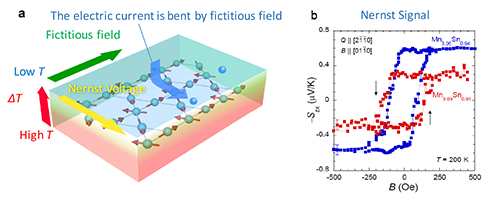New technology to generate electricity from heat using a magnet
Discovery of the large anomalous Nernst effect in an antiferromagnet
Researchers at the University of Tokyo have demonstrated large anomalous magneto-thermoelectric effect in an antiferromagnetic material, comparable to those found in ferromagnets. Their study provides a novel, and potentially useful guideline for future search of thermoelectric materials.
Summary
Dr.Takahiro Tomita, Research Fellow, Ikhlas Muhammad, and Prof. Satoru Nakatsuji from the University of Tokyo and their collaborators from RIKEN observed an unexpectedly large thermomagnetic effect, called the anomalous Nernst effect, in an antiferromagnet for the first time. The anomalous Nernst effect is the transverse voltage generated spontaneously when a magnetic conductor is exposed to a temperature gradient. Since its discovery about a century ago, this effect has long been assumed to be proportional to the magnetization of the material and to appear only in ferromagnets, and thus it was not expected to appear in materials with zero magnetization like antiferromagnets. Strikingly, the joint team by UTokyo and RIKEN found a large anomoalous Nerst effect in crystals of non-collinear antiferromagnetic metal Mn3Sn.

(a) In the anomalous Nernst effect, the electromotive force is generated perpendicular to both the magnetization and thermal gradient.
(b) As a result, the large anomalous Nernst signal can be observed with spontaneous magnetization as shown in (b).
Background
The anomalous Nernst effect shares a similar origin with the anomalous Hall effect, which is the spontaneous voltage generated across an electric current commonly found in ferromagnets. According to the modern theory of electron transport, these two phenomena are linked by a quantity known as Berry curvature, a “fictitious” magnetic field that can deflect the motion of electrons as real magnetic field itself does. Based on this theory, certain class antiferomagnets, those with non-collinear arrangements of magnetic moments, were expected to show large anomalous Hall conductivity. In fact, the same research group in the University of Tokyo was the first to experimentally verify this prediction in the non-collinear antiferromagnetic metal Mn3Sn.
Research result
Now, the research group led by Professor Satoru Nakatsuji at the University of Tokyo’s Institute for Solid State studied the anomalous Nernst effect in their newly synthesized large single crystals of Mn3Sn. Surprisingly they found that the anomalous Nernst effect in Mn3Sn is 100 times larger than the estimate based on its magnetization, on par with the highest value measured for a ferromagnetic metal. Experiments on two crystals with different compositions are qualitatively consistent with calculation performed by the team in RIKEN that suggests the presence of an exotic relativistic particle called the Weyl fermion as the source of large fictitious magnetic field. If verified through other experiments in the future, this would make Mn3Sn the long sought-after magnetic Weyl metal.
In terms of application, the anomalous Nernst effect has escaped much commercial interest, due to its significantly smaller magnitude compared to the much more well-known and utilized thermoelectric effect, the Seebeck effect, in nonmagnetic semiconductors. On the other hand, the advantage of thermoelectric generator based on the Nernst effect comes in the relatively simpler design of thermoelectric device, which in turn, allows more efficient coverage of the heat source. “Although the effect is relatively large compared to those found in ferromagnets, the magnitude of the effect that we have found is still too low for practical purposes”, said Prof. Nakatsuji. He continues, “However, this study is only the tip of the iceberg. We hope that our work can pave a way to discovering novel, thermoelectric materials in the future”.
Reference
- Authors: Muhammad Ikhlas, Takahiro Tomita, Takashi Koretsune, Michi-To Suzuki, Daisuke Nishio-Hamane, Ryotaro Arita, Satoru Nakatsuji, Yoshichika Otani
- Title: Large anomalous Nernst effect at room temperature in a chiral antiferromagnet
- Journal: Nature Physics
- DOI: 10.1038/nphys4181
Acknowledgements
This study was supported by Strategic Basic Research Programs (CREST) of the Japan Science and Technology Agency (JST) as a project covering “From understanding of topological electronic structure toward development of basic technology for energy harvesting” in the research area “Scientific Innovation for Energy Harvesting Technology.”
Related Link
- Nakatsuji Lab, ISSP, the University of Tokyo
